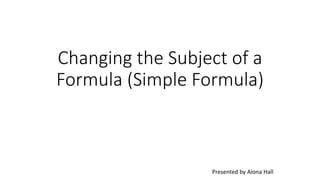
Changing the subject of a formula (Simple Formulae)
- 1. Changing the Subject of a Formula (Simple Formula) Presented by Alona Hall Substitute Numbers for Variables in Algebraic Expressions
- 2. Simple Formulae Involving the Four Basic Operations The objectives of this lesson serves to accomplish the following: 1. Provide an explanation of the concept ‘changing the subject of a formula’ 2. Demonstrate the procedure related to ‘changing the subject’ in formulae involving Addition and Subtraction Multiplication and Division A combination of the aforementioned operations 3. Introduce a shorter method for ‘changing the subject of a formula’ or ‘transposing.’
- 3. The Concept Given the formula Area of a rectangle = length x width (written A = lw), we say that A is the subject of the formula and this is so because: It is on the left hand side (the subject usually is) The coefficient is 1 The power is 1 It is in the numerator If, however, we are interested in finding the length of the rectangle (l), then we would get 𝑙 = 𝐴 𝑤 . We say that the subject of the formula has been changed to l.
- 4. The Concept The topic ‘changing the subject of a formula’ therefore implies that: • A formula will be given • It will have a subject • The subject must be changed to something else
- 5. Procedure Related to “changing the subject” Think of the following process: I walk two steps forward, jump three steps left, make a 180° turn clockwise, then throw a ball to Ralph. Question: How do I undo that process to get back to the starting point? Consider this: Ralph would throw the ball back to me, I would make a 180° turn anti-clockwise, jump three steps right, step two steps backward. (All things being equal, I should be back at the starting point)
- 6. Procedure Related to “changing the subject” In order to get back to the starting point, we had to ‘reverse’ which involved ‘undoing’ that is ‘doing the opposite of what was done’. In the context of mathematics, we will be doing the inverse of what was done. Importantly, we must identify what is done to the subject in order to determine what must be ‘undone’. THUS: THE SAME RULES USED TO SOLVE AN EQUATION WILL BE APPLIED
- 7. Operation Inverse Operation Addition/Positive Number Subtraction/Negative Number Subtraction Addition Multiplication Division Division Multiplication Operations and Their Inverses
- 8. Examples Change the subject of the following formulae to the subject indicated in brackets: 1. V = u + t (u) 2. 2𝜋𝑓 = 𝑤1 - 𝑤2 (𝑤1) 3. 𝐼 = 𝑛𝐴𝑣𝑒 (𝐴) 4. 𝑝 = 𝐹 𝐴 (F) 5. 𝑣2= ݑ2+2ܽݏ (a)
- 9. Solutions 1. v = u + t (u) Identify what was done to the required subject, u, and ‘undo it’. t was added to u so: Subtract t from both sides 𝑣 − 𝑡 = 𝑢 rewrite the formula with subject, 𝑢, on the left 𝑢 = 𝑣 − 𝑡 NB: The rules used for solving equations were applied
- 10. Solutions 2. 2𝜋𝑓 = 𝑤1 - 𝑤2 (𝑤1) 𝑤2 𝑤𝑎𝑠 𝑠𝑢𝑏𝑡𝑟𝑎𝑐𝑡𝑒𝑑 𝑓𝑟𝑜𝑚 𝑤1 so: 𝑎𝑑𝑑 𝑤2 𝑡𝑜 𝑏𝑜𝑡ℎ 𝑠𝑖𝑑𝑒𝑠 2𝜋𝑓 + 𝑤2 = 𝑤1 Rewrite to get: 𝑤1 = 2𝜋𝑓 + 𝑤2
- 11. Solutions 3. 𝐼 = 𝑛𝐴𝑣𝑒 (𝐴) 𝐴 𝑤𝑎𝑠 𝑚𝑢𝑙𝑡𝑖𝑝𝑙𝑖𝑒𝑑 𝑏𝑦 𝑛𝑣𝑒 𝑠𝑜: 𝑑𝑖𝑣𝑖𝑑𝑒 𝑏𝑜𝑡ℎ 𝑠𝑖𝑑𝑒𝑠 𝑏𝑦 𝑛𝑣𝑒 𝐼 𝑛𝑣𝑒 = 𝐴 𝑟𝑒𝑤𝑟𝑖𝑡𝑒 𝑡𝑜 𝑔𝑒𝑡: 𝐴 = 𝐼 𝑛𝑣𝑒
- 12. Solutions 4. 𝑝 = 𝐹 𝐴 (F) 𝐹 𝑖𝑠 𝑏𝑒𝑖𝑛𝑔 𝑑𝑖𝑣𝑖𝑑𝑒𝑑 𝑏𝑦 𝐴 𝑠𝑜: 𝑚𝑢𝑙𝑡𝑖𝑝𝑙𝑦 𝑏𝑜𝑡ℎ 𝑠𝑖𝑑𝑒𝑠 𝑏𝑦 𝐴 𝐴𝑝 = 𝐹 𝑟𝑒𝑤𝑟𝑖𝑡𝑒 𝑡𝑜 𝑔𝑒𝑡: 𝐹 = 𝐴𝑝
- 13. Solutions 5. 𝑣2 = ݑ2 +2ܽݏ (a) 𝑎 𝑤𝑎𝑠 𝑚𝑢𝑙𝑡𝑖𝑝𝑙𝑖𝑒𝑑 𝑏𝑦 2𝑠 𝑡ℎ𝑒𝑛 𝑢2 𝑤𝑎𝑠 𝑎𝑑𝑑𝑒𝑑 𝑠𝑜: (𝑟𝑒𝑣𝑒𝑟𝑠𝑒 𝑡ℎ𝑒 𝑜𝑟𝑑𝑒𝑟) 𝑠𝑢𝑏𝑡𝑟𝑎𝑐𝑡 𝑢2 𝑓𝑟𝑜𝑚 𝑏𝑜𝑡ℎ 𝑠𝑖𝑑𝑒𝑠 𝑣2 −𝑢2 = 2ܽݏ 𝑡ℎ𝑒𝑛 𝑑𝑖𝑣𝑖𝑑𝑒 𝑏𝑜𝑡ℎ 𝑠𝑖𝑑𝑒𝑠 𝑏𝑦 2𝑠 𝑟𝑒𝑤𝑟𝑖𝑡𝑒 𝑡𝑜 𝑔𝑒𝑡:
- 14. A Shorter Method Remember the principle: In order to ‘undo’ what was done to the subject we go in reverse order and use the inverse operation.
- 15. Example Make c the subject in the formula: 𝐹 −32 𝑐 = 9 5 Solution: 𝑐 𝑠ℎ𝑜𝑢𝑙𝑑 𝑏𝑒 𝑖𝑛 𝑡ℎ𝑒 𝑛𝑢𝑚𝑒𝑟𝑎𝑡𝑜𝑟. 𝑊𝑒 ℎ𝑎𝑣𝑒 ÷ 𝑏𝑦 𝑐 𝑜𝑛 𝑡ℎ𝑒 𝑙𝑒𝑓𝑡 ℎ𝑎𝑛𝑑 𝑠𝑖𝑑𝑒 𝐿𝐻𝑆 Inverse 𝑜𝑝𝑒𝑟𝑎𝑡𝑖𝑜𝑛 𝑖𝑠 × 𝑐 𝑏𝑢𝑡 𝑠ℎ𝑜𝑤 𝑖𝑡 𝑜𝑛 𝑡ℎ𝑒 𝑟𝑖𝑔ℎ𝑡 ℎ𝑎𝑛𝑑 𝑠𝑖𝑑𝑒 (𝑅𝐻𝑆) 𝐹 − 32 = 9 5 × 𝑐 𝑁𝑜𝑤 𝑐 𝑖𝑠 𝑏𝑒𝑖𝑛𝑔 𝑚𝑢𝑙𝑡𝑖𝑝𝑙𝑖𝑒𝑑 𝑏𝑦 9 5 so divide by 9 5 𝑜𝑛 𝑡ℎ𝑒 𝑜𝑡ℎ𝑒𝑟 𝑠𝑖𝑑𝑒 Remember that dividing by a fraction is the same as multiplying by its reciprocal (turn the fraction upside down 5 9 )
- 16. Solution (cont’d) 5 9 𝐹 − 32 = 𝑐 𝑐 = 5 9 𝐹 − 32 𝑖𝑛𝑡𝑟𝑜𝑑𝑢𝑐𝑒 𝑏𝑟𝑎𝑐𝑘𝑒𝑡𝑠, 𝑡ℎ𝑎𝑡 𝑖𝑠, 5 9 𝐹 − 32 𝑡𝑜 𝑠ℎ𝑜𝑤 𝑡ℎ𝑎𝑡 5 9 is multiplying everything on the other side. F − 32 was on the other side.
- 17. Consider this alternative solution Make c the subject in the formula: 𝐹 −32 𝑐 = 9 5 𝑐 𝑚𝑢𝑠𝑡 𝑏𝑒 𝑖𝑛 𝑡ℎ𝑒 𝑛𝑢𝑚𝑒𝑟𝑎𝑡𝑜𝑟 𝑠𝑜: 𝑓𝑙𝑖𝑝 𝑡ℎ𝑒 𝐿𝐻𝑆 𝑤ℎ𝑖𝑐ℎ 𝑖𝑚𝑝𝑙𝑖𝑒𝑠 𝑡ℎ𝑎𝑡 𝑡ℎ𝑒 𝑅𝐻𝑆 𝑚𝑢𝑠𝑡 𝑏𝑒 𝑓𝑙𝑖𝑝𝑝𝑒𝑑 𝑎𝑠 𝑤𝑒𝑙𝑙 𝑐 𝐹 − 32 = 5 9 𝐹 − 32 𝑖𝑠 𝑑𝑖𝑣𝑖𝑑𝑖𝑛𝑔 𝑜𝑛 𝑡ℎ𝑒 𝐿𝐻𝑆 𝑠𝑜 𝑚𝑢𝑙𝑡𝑖𝑝𝑙𝑦 𝑏𝑦 𝐹 − 32 𝑜𝑛 𝑡ℎ𝑒 𝑅𝐻𝑆 𝑐 = 5 9 (𝐹 − 32) REMEMBER: 𝐵𝑟𝑎𝑐𝑘𝑒𝑡 𝑚𝑢𝑠𝑡 𝑒𝑛𝑐𝑙𝑜𝑠𝑒 𝐹 − 32 𝑡𝑜 𝑠ℎ𝑜𝑤 𝑡ℎ𝑎𝑡 5 9 𝑖𝑠 𝑚𝑢𝑙𝑡𝑖𝑝𝑙𝑦𝑖𝑛𝑔 𝑏𝑜𝑡ℎ 𝑡𝑒𝑟𝑚𝑠. Without brackets, we would have 5 9 F − 32 which has a DIFFERENT meaning.